An Evaluation of Management and Leadership Roles at HSBC Bank
VerifiedAdded on 2020/06/04
|16
|5125
|131
Report
AI Summary
This report provides an in-depth analysis of management and leadership roles within HSBC Bank. It begins with an introduction to the bank's structure and the importance of operations management in delivering quality services. The report then differentiates between the roles of leaders and managers, exploring their functions and how they complement each other. It examines various leadership styles, including autocratic and democratic approaches, and discusses the strengths and weaknesses of each. The report also delves into the role of risk management within HSBC, highlighting the functions of the risk management department and the skills and duties of the management team. Furthermore, the report appreciates the importance of incorporating new technologies and innovations to improve efficiency and customer satisfaction. It covers the importance of communication, goal setting and managing resources. The report also discusses the advantages and disadvantages of different leadership approaches and the skills needed for effective management. The report highlights the importance of adapting to changes in the business environment and making effective decisions. The report aims to provide a comprehensive overview of management and leadership in the context of a large financial institution.
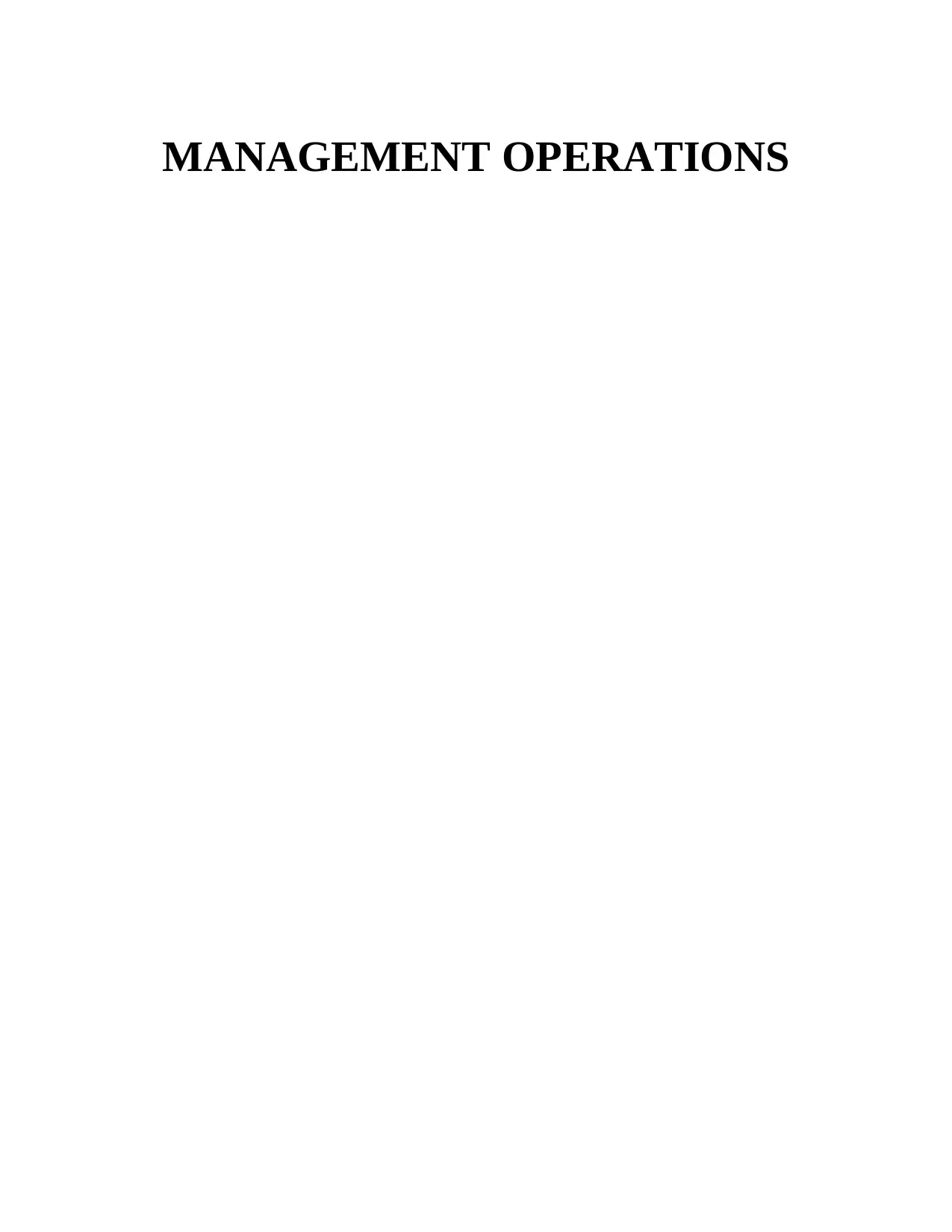
MANAGEMENT OPERATIONS
Paraphrase This Document
Need a fresh take? Get an instant paraphrase of this document with our AI Paraphraser
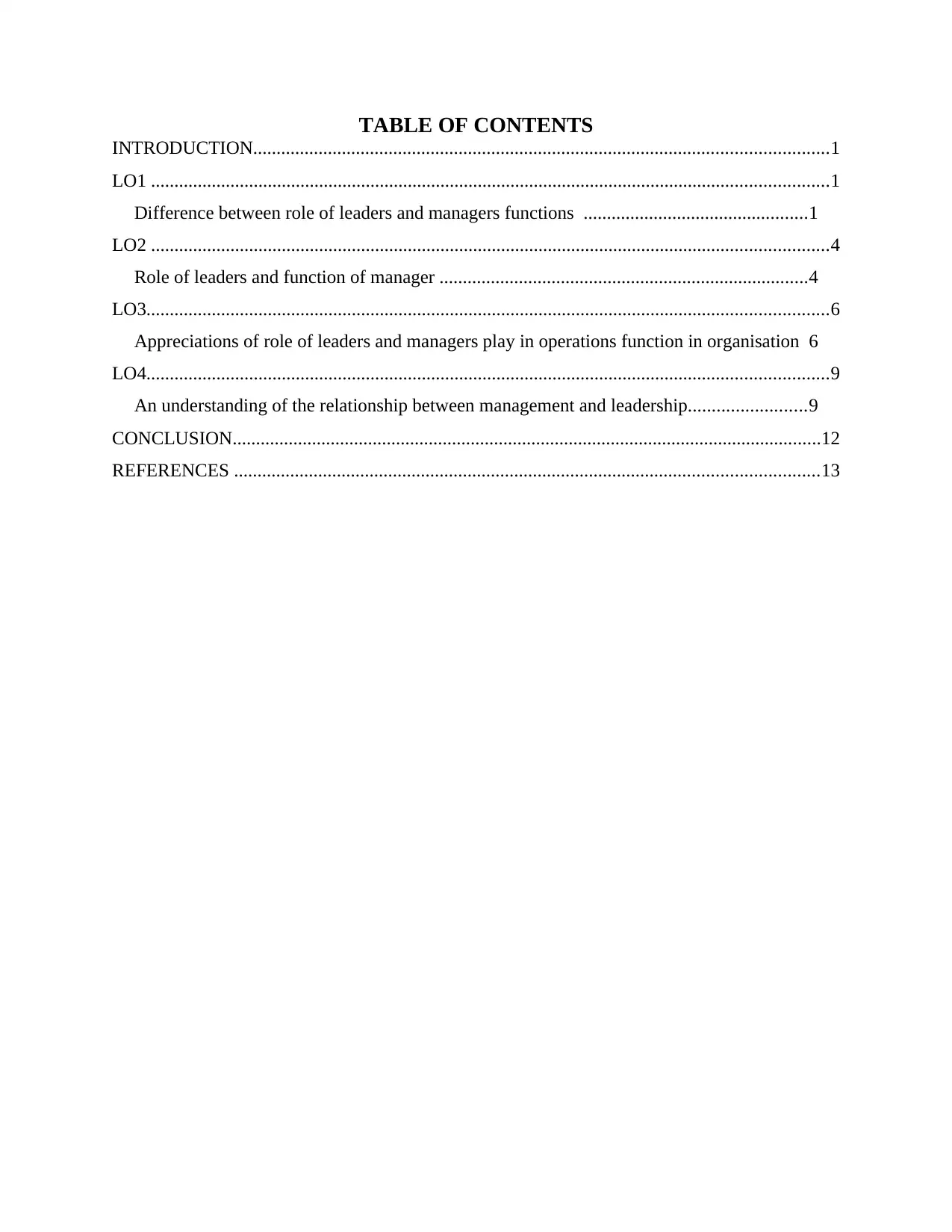
TABLE OF CONTENTS
INTRODUCTION...........................................................................................................................1
LO1 .................................................................................................................................................1
Difference between role of leaders and managers functions ................................................1
LO2 .................................................................................................................................................4
Role of leaders and function of manager ...............................................................................4
LO3..................................................................................................................................................6
Appreciations of role of leaders and managers play in operations function in organisation 6
LO4..................................................................................................................................................9
An understanding of the relationship between management and leadership.........................9
CONCLUSION..............................................................................................................................12
REFERENCES .............................................................................................................................13
INTRODUCTION...........................................................................................................................1
LO1 .................................................................................................................................................1
Difference between role of leaders and managers functions ................................................1
LO2 .................................................................................................................................................4
Role of leaders and function of manager ...............................................................................4
LO3..................................................................................................................................................6
Appreciations of role of leaders and managers play in operations function in organisation 6
LO4..................................................................................................................................................9
An understanding of the relationship between management and leadership.........................9
CONCLUSION..............................................................................................................................12
REFERENCES .............................................................................................................................13
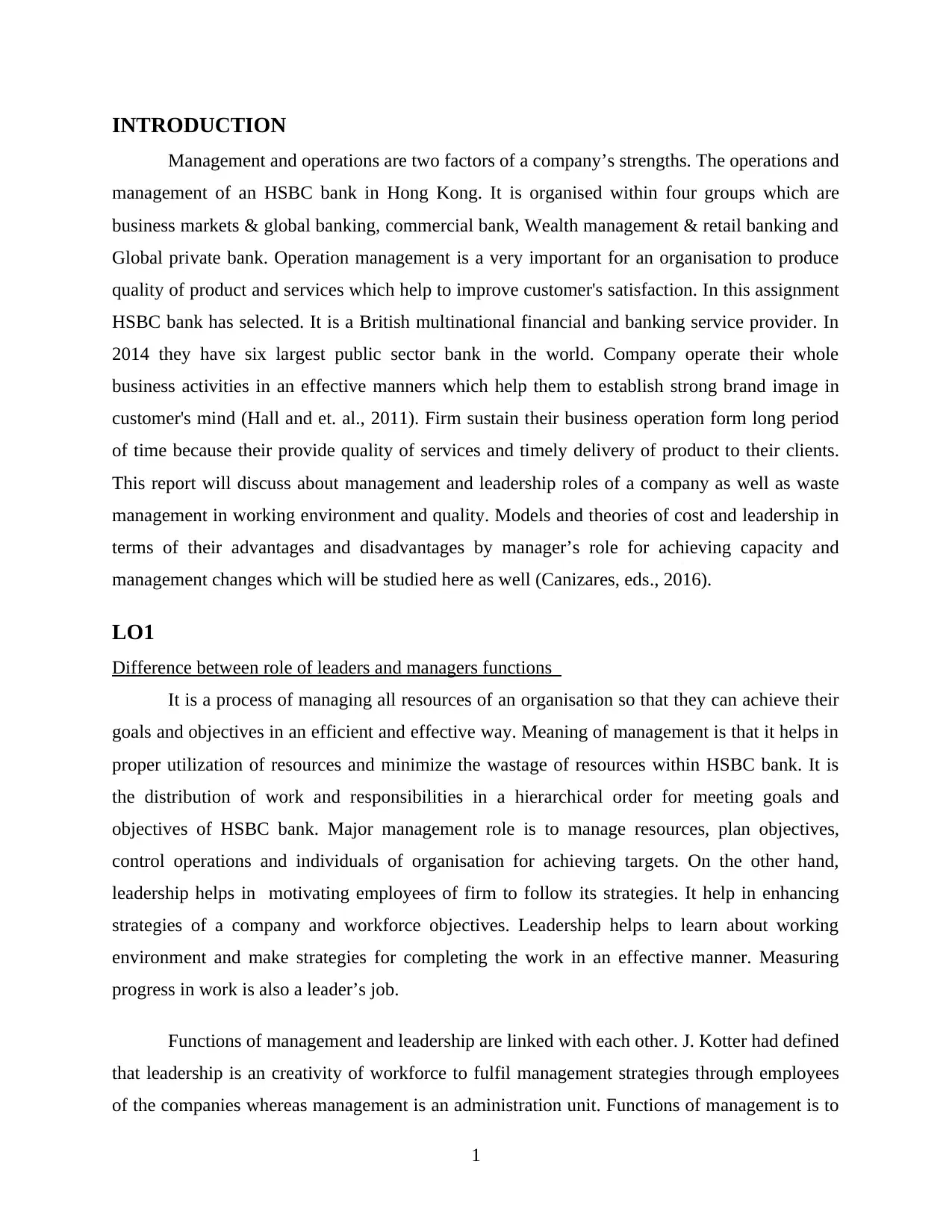
INTRODUCTION
Management and operations are two factors of a company’s strengths. The operations and
management of an HSBC bank in Hong Kong. It is organised within four groups which are
business markets & global banking, commercial bank, Wealth management & retail banking and
Global private bank. Operation management is a very important for an organisation to produce
quality of product and services which help to improve customer's satisfaction. In this assignment
HSBC bank has selected. It is a British multinational financial and banking service provider. In
2014 they have six largest public sector bank in the world. Company operate their whole
business activities in an effective manners which help them to establish strong brand image in
customer's mind (Hall and et. al., 2011). Firm sustain their business operation form long period
of time because their provide quality of services and timely delivery of product to their clients.
This report will discuss about management and leadership roles of a company as well as waste
management in working environment and quality. Models and theories of cost and leadership in
terms of their advantages and disadvantages by manager’s role for achieving capacity and
management changes which will be studied here as well (Canizares, eds., 2016).
LO1
Difference between role of leaders and managers functions
It is a process of managing all resources of an organisation so that they can achieve their
goals and objectives in an efficient and effective way. Meaning of management is that it helps in
proper utilization of resources and minimize the wastage of resources within HSBC bank. It is
the distribution of work and responsibilities in a hierarchical order for meeting goals and
objectives of HSBC bank. Major management role is to manage resources, plan objectives,
control operations and individuals of organisation for achieving targets. On the other hand,
leadership helps in motivating employees of firm to follow its strategies. It help in enhancing
strategies of a company and workforce objectives. Leadership helps to learn about working
environment and make strategies for completing the work in an effective manner. Measuring
progress in work is also a leader’s job.
Functions of management and leadership are linked with each other. J. Kotter had defined
that leadership is an creativity of workforce to fulfil management strategies through employees
of the companies whereas management is an administration unit. Functions of management is to
1
Management and operations are two factors of a company’s strengths. The operations and
management of an HSBC bank in Hong Kong. It is organised within four groups which are
business markets & global banking, commercial bank, Wealth management & retail banking and
Global private bank. Operation management is a very important for an organisation to produce
quality of product and services which help to improve customer's satisfaction. In this assignment
HSBC bank has selected. It is a British multinational financial and banking service provider. In
2014 they have six largest public sector bank in the world. Company operate their whole
business activities in an effective manners which help them to establish strong brand image in
customer's mind (Hall and et. al., 2011). Firm sustain their business operation form long period
of time because their provide quality of services and timely delivery of product to their clients.
This report will discuss about management and leadership roles of a company as well as waste
management in working environment and quality. Models and theories of cost and leadership in
terms of their advantages and disadvantages by manager’s role for achieving capacity and
management changes which will be studied here as well (Canizares, eds., 2016).
LO1
Difference between role of leaders and managers functions
It is a process of managing all resources of an organisation so that they can achieve their
goals and objectives in an efficient and effective way. Meaning of management is that it helps in
proper utilization of resources and minimize the wastage of resources within HSBC bank. It is
the distribution of work and responsibilities in a hierarchical order for meeting goals and
objectives of HSBC bank. Major management role is to manage resources, plan objectives,
control operations and individuals of organisation for achieving targets. On the other hand,
leadership helps in motivating employees of firm to follow its strategies. It help in enhancing
strategies of a company and workforce objectives. Leadership helps to learn about working
environment and make strategies for completing the work in an effective manner. Measuring
progress in work is also a leader’s job.
Functions of management and leadership are linked with each other. J. Kotter had defined
that leadership is an creativity of workforce to fulfil management strategies through employees
of the companies whereas management is an administration unit. Functions of management is to
1
⊘ This is a preview!⊘
Do you want full access?
Subscribe today to unlock all pages.

Trusted by 1+ million students worldwide
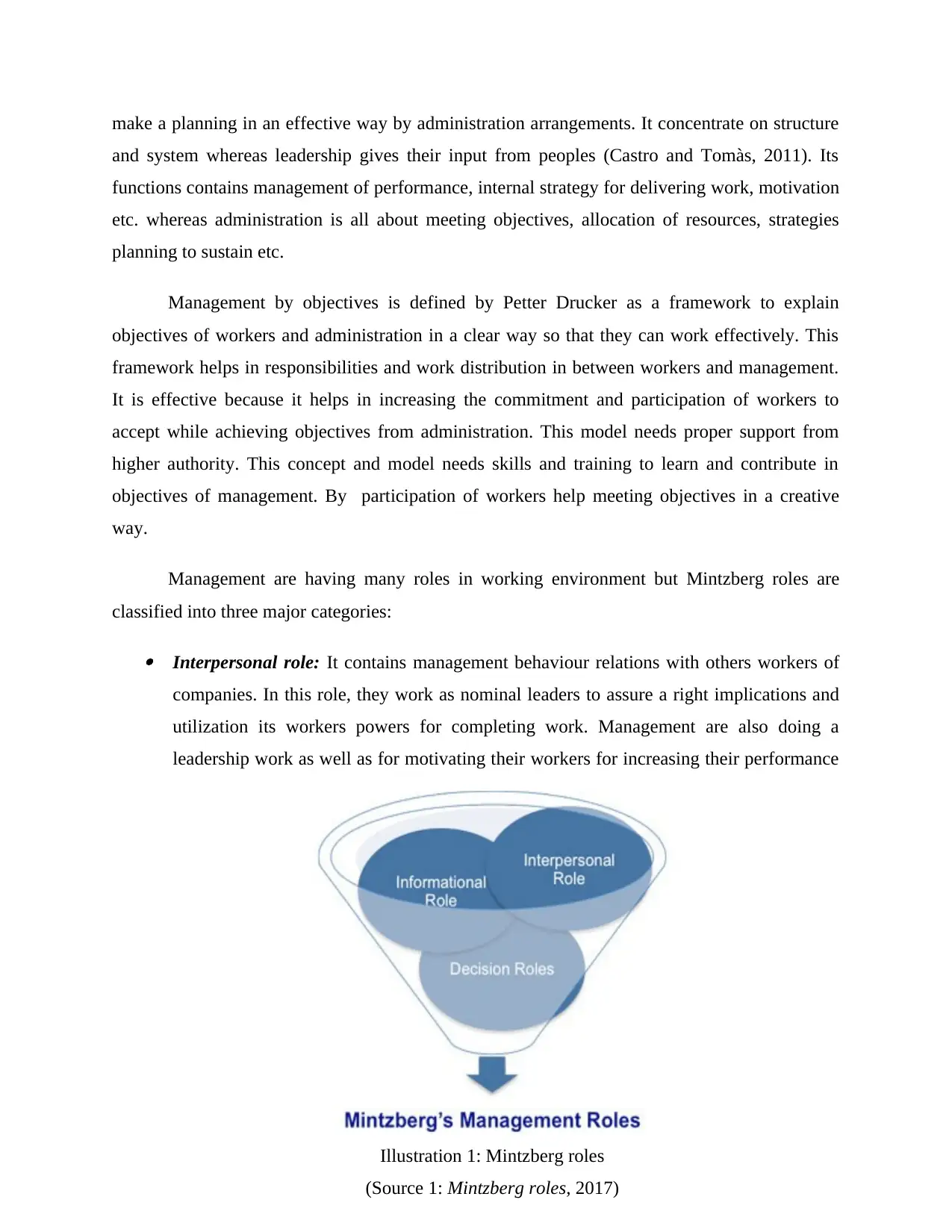
make a planning in an effective way by administration arrangements. It concentrate on structure
and system whereas leadership gives their input from peoples (Castro and Tomàs, 2011). Its
functions contains management of performance, internal strategy for delivering work, motivation
etc. whereas administration is all about meeting objectives, allocation of resources, strategies
planning to sustain etc.
Management by objectives is defined by Petter Drucker as a framework to explain
objectives of workers and administration in a clear way so that they can work effectively. This
framework helps in responsibilities and work distribution in between workers and management.
It is effective because it helps in increasing the commitment and participation of workers to
accept while achieving objectives from administration. This model needs proper support from
higher authority. This concept and model needs skills and training to learn and contribute in
objectives of management. By participation of workers help meeting objectives in a creative
way.
Management are having many roles in working environment but Mintzberg roles are
classified into three major categories:
Interpersonal role: It contains management behaviour relations with others workers of
companies. In this role, they work as nominal leaders to assure a right implications and
utilization its workers powers for completing work. Management are also doing a
leadership work as well as for motivating their workers for increasing their performance
2Illustration 1: Mintzberg roles
(Source 1: Mintzberg roles, 2017)
and system whereas leadership gives their input from peoples (Castro and Tomàs, 2011). Its
functions contains management of performance, internal strategy for delivering work, motivation
etc. whereas administration is all about meeting objectives, allocation of resources, strategies
planning to sustain etc.
Management by objectives is defined by Petter Drucker as a framework to explain
objectives of workers and administration in a clear way so that they can work effectively. This
framework helps in responsibilities and work distribution in between workers and management.
It is effective because it helps in increasing the commitment and participation of workers to
accept while achieving objectives from administration. This model needs proper support from
higher authority. This concept and model needs skills and training to learn and contribute in
objectives of management. By participation of workers help meeting objectives in a creative
way.
Management are having many roles in working environment but Mintzberg roles are
classified into three major categories:
Interpersonal role: It contains management behaviour relations with others workers of
companies. In this role, they work as nominal leaders to assure a right implications and
utilization its workers powers for completing work. Management are also doing a
leadership work as well as for motivating their workers for increasing their performance
2Illustration 1: Mintzberg roles
(Source 1: Mintzberg roles, 2017)
Paraphrase This Document
Need a fresh take? Get an instant paraphrase of this document with our AI Paraphraser
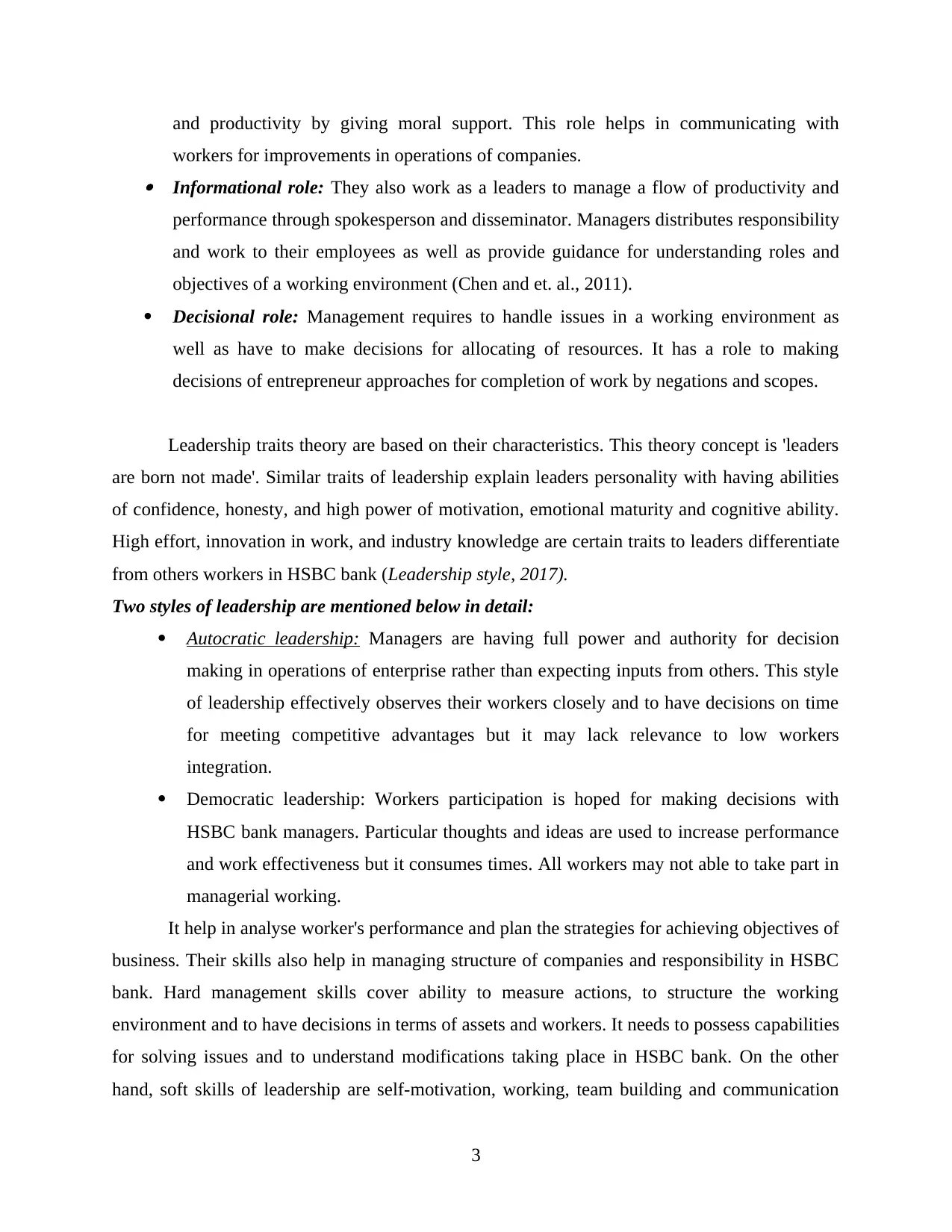
and productivity by giving moral support. This role helps in communicating with
workers for improvements in operations of companies. Informational role: They also work as a leaders to manage a flow of productivity and
performance through spokesperson and disseminator. Managers distributes responsibility
and work to their employees as well as provide guidance for understanding roles and
objectives of a working environment (Chen and et. al., 2011).
Decisional role: Management requires to handle issues in a working environment as
well as have to make decisions for allocating of resources. It has a role to making
decisions of entrepreneur approaches for completion of work by negations and scopes.
Leadership traits theory are based on their characteristics. This theory concept is 'leaders
are born not made'. Similar traits of leadership explain leaders personality with having abilities
of confidence, honesty, and high power of motivation, emotional maturity and cognitive ability.
High effort, innovation in work, and industry knowledge are certain traits to leaders differentiate
from others workers in HSBC bank (Leadership style, 2017).
Two styles of leadership are mentioned below in detail:
Autocratic leadership: Managers are having full power and authority for decision
making in operations of enterprise rather than expecting inputs from others. This style
of leadership effectively observes their workers closely and to have decisions on time
for meeting competitive advantages but it may lack relevance to low workers
integration.
Democratic leadership: Workers participation is hoped for making decisions with
HSBC bank managers. Particular thoughts and ideas are used to increase performance
and work effectiveness but it consumes times. All workers may not able to take part in
managerial working.
It help in analyse worker's performance and plan the strategies for achieving objectives of
business. Their skills also help in managing structure of companies and responsibility in HSBC
bank. Hard management skills cover ability to measure actions, to structure the working
environment and to have decisions in terms of assets and workers. It needs to possess capabilities
for solving issues and to understand modifications taking place in HSBC bank. On the other
hand, soft skills of leadership are self-motivation, working, team building and communication
3
workers for improvements in operations of companies. Informational role: They also work as a leaders to manage a flow of productivity and
performance through spokesperson and disseminator. Managers distributes responsibility
and work to their employees as well as provide guidance for understanding roles and
objectives of a working environment (Chen and et. al., 2011).
Decisional role: Management requires to handle issues in a working environment as
well as have to make decisions for allocating of resources. It has a role to making
decisions of entrepreneur approaches for completion of work by negations and scopes.
Leadership traits theory are based on their characteristics. This theory concept is 'leaders
are born not made'. Similar traits of leadership explain leaders personality with having abilities
of confidence, honesty, and high power of motivation, emotional maturity and cognitive ability.
High effort, innovation in work, and industry knowledge are certain traits to leaders differentiate
from others workers in HSBC bank (Leadership style, 2017).
Two styles of leadership are mentioned below in detail:
Autocratic leadership: Managers are having full power and authority for decision
making in operations of enterprise rather than expecting inputs from others. This style
of leadership effectively observes their workers closely and to have decisions on time
for meeting competitive advantages but it may lack relevance to low workers
integration.
Democratic leadership: Workers participation is hoped for making decisions with
HSBC bank managers. Particular thoughts and ideas are used to increase performance
and work effectiveness but it consumes times. All workers may not able to take part in
managerial working.
It help in analyse worker's performance and plan the strategies for achieving objectives of
business. Their skills also help in managing structure of companies and responsibility in HSBC
bank. Hard management skills cover ability to measure actions, to structure the working
environment and to have decisions in terms of assets and workers. It needs to possess capabilities
for solving issues and to understand modifications taking place in HSBC bank. On the other
hand, soft skills of leadership are self-motivation, working, team building and communication
3
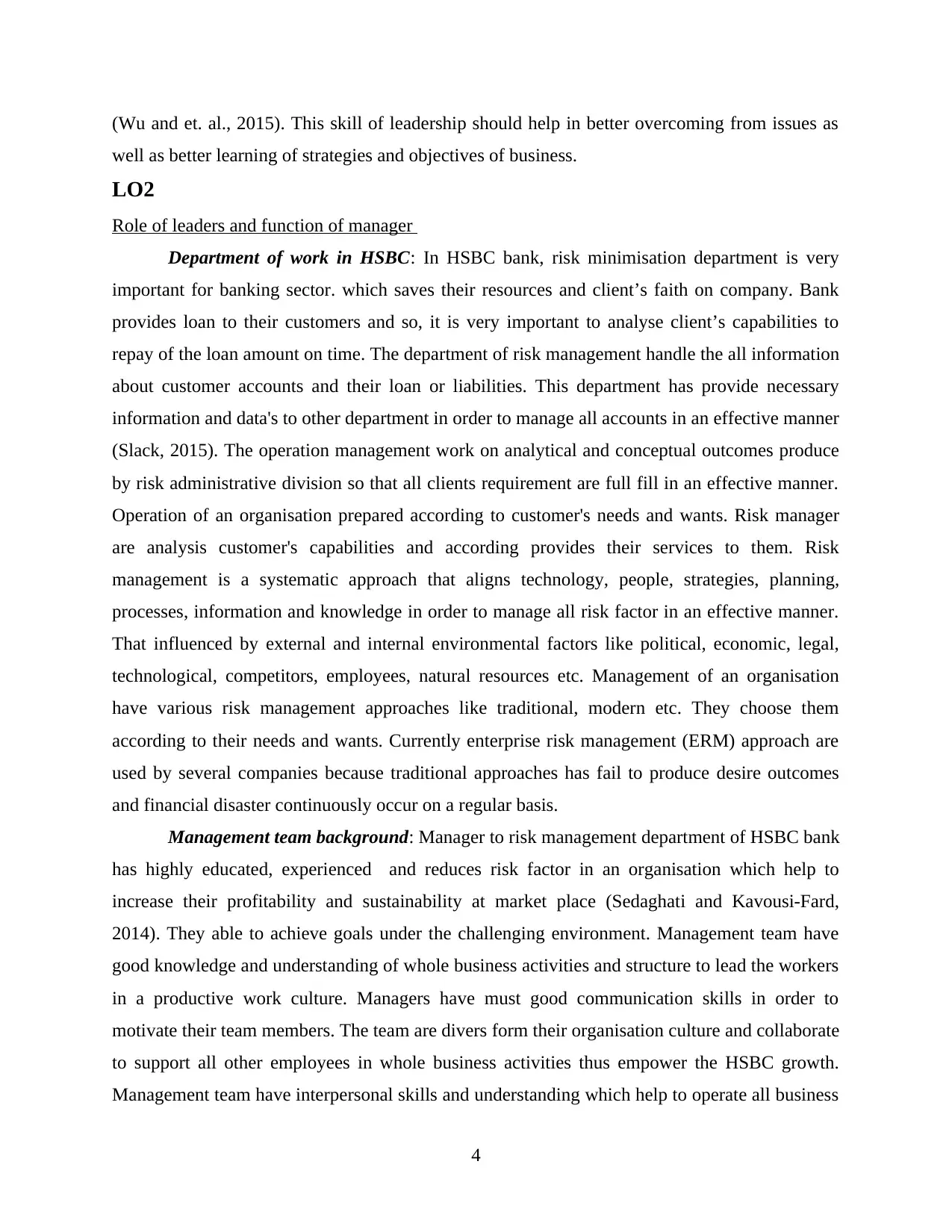
(Wu and et. al., 2015). This skill of leadership should help in better overcoming from issues as
well as better learning of strategies and objectives of business.
LO2
Role of leaders and function of manager
Department of work in HSBC: In HSBC bank, risk minimisation department is very
important for banking sector. which saves their resources and client’s faith on company. Bank
provides loan to their customers and so, it is very important to analyse client’s capabilities to
repay of the loan amount on time. The department of risk management handle the all information
about customer accounts and their loan or liabilities. This department has provide necessary
information and data's to other department in order to manage all accounts in an effective manner
(Slack, 2015). The operation management work on analytical and conceptual outcomes produce
by risk administrative division so that all clients requirement are full fill in an effective manner.
Operation of an organisation prepared according to customer's needs and wants. Risk manager
are analysis customer's capabilities and according provides their services to them. Risk
management is a systematic approach that aligns technology, people, strategies, planning,
processes, information and knowledge in order to manage all risk factor in an effective manner.
That influenced by external and internal environmental factors like political, economic, legal,
technological, competitors, employees, natural resources etc. Management of an organisation
have various risk management approaches like traditional, modern etc. They choose them
according to their needs and wants. Currently enterprise risk management (ERM) approach are
used by several companies because traditional approaches has fail to produce desire outcomes
and financial disaster continuously occur on a regular basis.
Management team background: Manager to risk management department of HSBC bank
has highly educated, experienced and reduces risk factor in an organisation which help to
increase their profitability and sustainability at market place (Sedaghati and Kavousi-Fard,
2014). They able to achieve goals under the challenging environment. Management team have
good knowledge and understanding of whole business activities and structure to lead the workers
in a productive work culture. Managers have must good communication skills in order to
motivate their team members. The team are divers form their organisation culture and collaborate
to support all other employees in whole business activities thus empower the HSBC growth.
Management team have interpersonal skills and understanding which help to operate all business
4
well as better learning of strategies and objectives of business.
LO2
Role of leaders and function of manager
Department of work in HSBC: In HSBC bank, risk minimisation department is very
important for banking sector. which saves their resources and client’s faith on company. Bank
provides loan to their customers and so, it is very important to analyse client’s capabilities to
repay of the loan amount on time. The department of risk management handle the all information
about customer accounts and their loan or liabilities. This department has provide necessary
information and data's to other department in order to manage all accounts in an effective manner
(Slack, 2015). The operation management work on analytical and conceptual outcomes produce
by risk administrative division so that all clients requirement are full fill in an effective manner.
Operation of an organisation prepared according to customer's needs and wants. Risk manager
are analysis customer's capabilities and according provides their services to them. Risk
management is a systematic approach that aligns technology, people, strategies, planning,
processes, information and knowledge in order to manage all risk factor in an effective manner.
That influenced by external and internal environmental factors like political, economic, legal,
technological, competitors, employees, natural resources etc. Management of an organisation
have various risk management approaches like traditional, modern etc. They choose them
according to their needs and wants. Currently enterprise risk management (ERM) approach are
used by several companies because traditional approaches has fail to produce desire outcomes
and financial disaster continuously occur on a regular basis.
Management team background: Manager to risk management department of HSBC bank
has highly educated, experienced and reduces risk factor in an organisation which help to
increase their profitability and sustainability at market place (Sedaghati and Kavousi-Fard,
2014). They able to achieve goals under the challenging environment. Management team have
good knowledge and understanding of whole business activities and structure to lead the workers
in a productive work culture. Managers have must good communication skills in order to
motivate their team members. The team are divers form their organisation culture and collaborate
to support all other employees in whole business activities thus empower the HSBC growth.
Management team have interpersonal skills and understanding which help to operate all business
4
⊘ This is a preview!⊘
Do you want full access?
Subscribe today to unlock all pages.

Trusted by 1+ million students worldwide
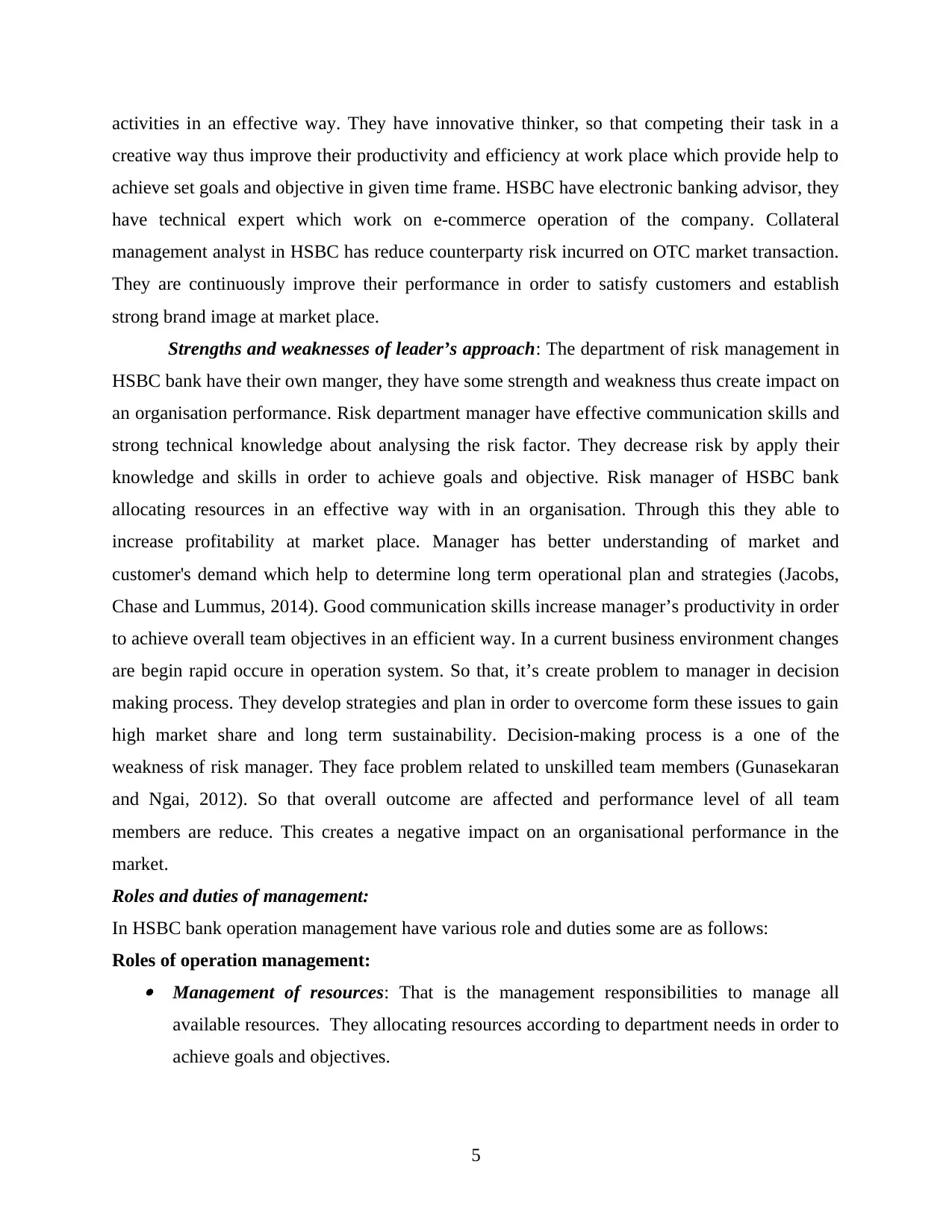
activities in an effective way. They have innovative thinker, so that competing their task in a
creative way thus improve their productivity and efficiency at work place which provide help to
achieve set goals and objective in given time frame. HSBC have electronic banking advisor, they
have technical expert which work on e-commerce operation of the company. Collateral
management analyst in HSBC has reduce counterparty risk incurred on OTC market transaction.
They are continuously improve their performance in order to satisfy customers and establish
strong brand image at market place.
Strengths and weaknesses of leader’s approach: The department of risk management in
HSBC bank have their own manger, they have some strength and weakness thus create impact on
an organisation performance. Risk department manager have effective communication skills and
strong technical knowledge about analysing the risk factor. They decrease risk by apply their
knowledge and skills in order to achieve goals and objective. Risk manager of HSBC bank
allocating resources in an effective way with in an organisation. Through this they able to
increase profitability at market place. Manager has better understanding of market and
customer's demand which help to determine long term operational plan and strategies (Jacobs,
Chase and Lummus, 2014). Good communication skills increase manager’s productivity in order
to achieve overall team objectives in an efficient way. In a current business environment changes
are begin rapid occure in operation system. So that, it’s create problem to manager in decision
making process. They develop strategies and plan in order to overcome form these issues to gain
high market share and long term sustainability. Decision-making process is a one of the
weakness of risk manager. They face problem related to unskilled team members (Gunasekaran
and Ngai, 2012). So that overall outcome are affected and performance level of all team
members are reduce. This creates a negative impact on an organisational performance in the
market.
Roles and duties of management:
In HSBC bank operation management have various role and duties some are as follows:
Roles of operation management: Management of resources: That is the management responsibilities to manage all
available resources. They allocating resources according to department needs in order to
achieve goals and objectives.
5
creative way thus improve their productivity and efficiency at work place which provide help to
achieve set goals and objective in given time frame. HSBC have electronic banking advisor, they
have technical expert which work on e-commerce operation of the company. Collateral
management analyst in HSBC has reduce counterparty risk incurred on OTC market transaction.
They are continuously improve their performance in order to satisfy customers and establish
strong brand image at market place.
Strengths and weaknesses of leader’s approach: The department of risk management in
HSBC bank have their own manger, they have some strength and weakness thus create impact on
an organisation performance. Risk department manager have effective communication skills and
strong technical knowledge about analysing the risk factor. They decrease risk by apply their
knowledge and skills in order to achieve goals and objective. Risk manager of HSBC bank
allocating resources in an effective way with in an organisation. Through this they able to
increase profitability at market place. Manager has better understanding of market and
customer's demand which help to determine long term operational plan and strategies (Jacobs,
Chase and Lummus, 2014). Good communication skills increase manager’s productivity in order
to achieve overall team objectives in an efficient way. In a current business environment changes
are begin rapid occure in operation system. So that, it’s create problem to manager in decision
making process. They develop strategies and plan in order to overcome form these issues to gain
high market share and long term sustainability. Decision-making process is a one of the
weakness of risk manager. They face problem related to unskilled team members (Gunasekaran
and Ngai, 2012). So that overall outcome are affected and performance level of all team
members are reduce. This creates a negative impact on an organisational performance in the
market.
Roles and duties of management:
In HSBC bank operation management have various role and duties some are as follows:
Roles of operation management: Management of resources: That is the management responsibilities to manage all
available resources. They allocating resources according to department needs in order to
achieve goals and objectives.
5
Paraphrase This Document
Need a fresh take? Get an instant paraphrase of this document with our AI Paraphraser
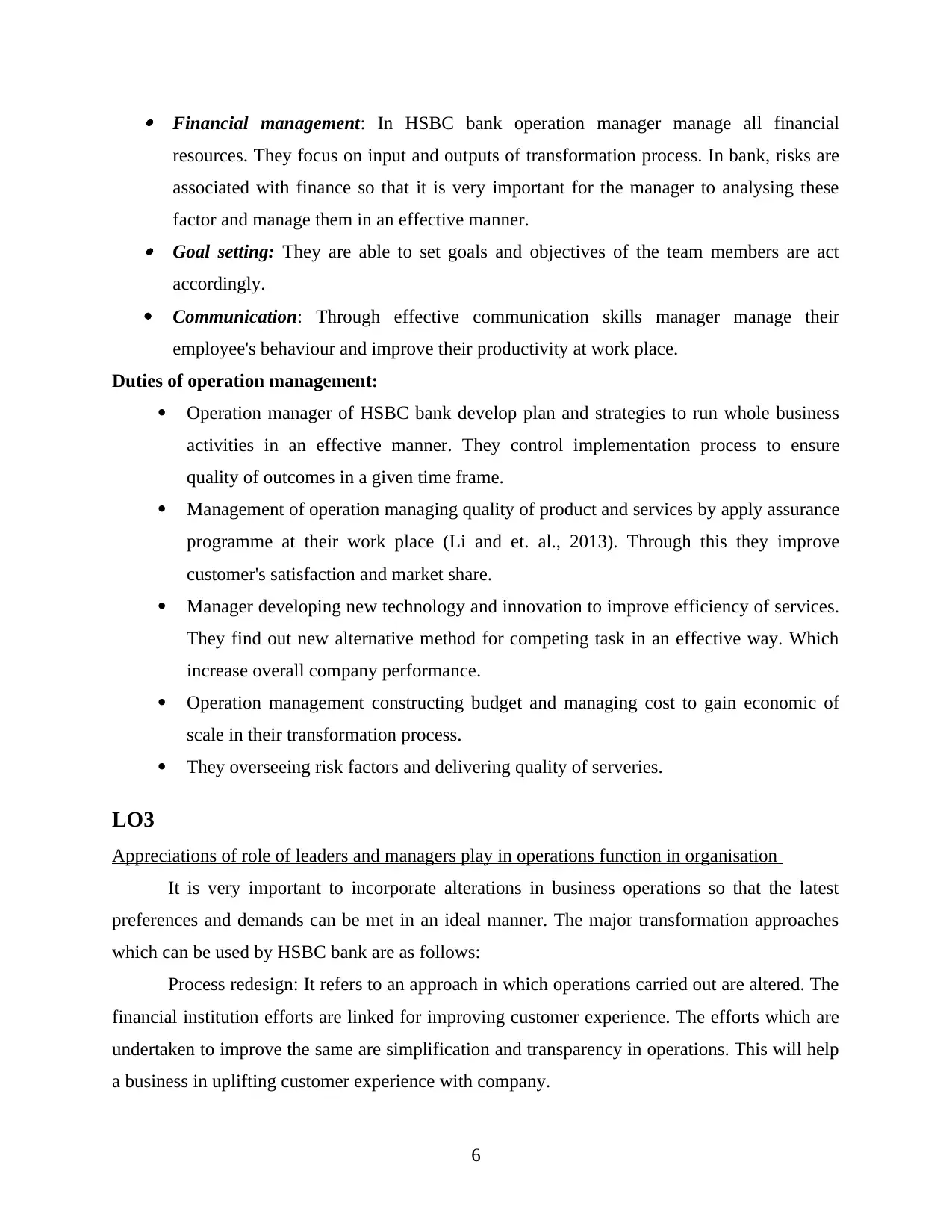
Financial management: In HSBC bank operation manager manage all financial
resources. They focus on input and outputs of transformation process. In bank, risks are
associated with finance so that it is very important for the manager to analysing these
factor and manage them in an effective manner. Goal setting: They are able to set goals and objectives of the team members are act
accordingly.
Communication: Through effective communication skills manager manage their
employee's behaviour and improve their productivity at work place.
Duties of operation management:
Operation manager of HSBC bank develop plan and strategies to run whole business
activities in an effective manner. They control implementation process to ensure
quality of outcomes in a given time frame.
Management of operation managing quality of product and services by apply assurance
programme at their work place (Li and et. al., 2013). Through this they improve
customer's satisfaction and market share.
Manager developing new technology and innovation to improve efficiency of services.
They find out new alternative method for competing task in an effective way. Which
increase overall company performance.
Operation management constructing budget and managing cost to gain economic of
scale in their transformation process.
They overseeing risk factors and delivering quality of serveries.
LO3
Appreciations of role of leaders and managers play in operations function in organisation
It is very important to incorporate alterations in business operations so that the latest
preferences and demands can be met in an ideal manner. The major transformation approaches
which can be used by HSBC bank are as follows:
Process redesign: It refers to an approach in which operations carried out are altered. The
financial institution efforts are linked for improving customer experience. The efforts which are
undertaken to improve the same are simplification and transparency in operations. This will help
a business in uplifting customer experience with company.
6
resources. They focus on input and outputs of transformation process. In bank, risks are
associated with finance so that it is very important for the manager to analysing these
factor and manage them in an effective manner. Goal setting: They are able to set goals and objectives of the team members are act
accordingly.
Communication: Through effective communication skills manager manage their
employee's behaviour and improve their productivity at work place.
Duties of operation management:
Operation manager of HSBC bank develop plan and strategies to run whole business
activities in an effective manner. They control implementation process to ensure
quality of outcomes in a given time frame.
Management of operation managing quality of product and services by apply assurance
programme at their work place (Li and et. al., 2013). Through this they improve
customer's satisfaction and market share.
Manager developing new technology and innovation to improve efficiency of services.
They find out new alternative method for competing task in an effective way. Which
increase overall company performance.
Operation management constructing budget and managing cost to gain economic of
scale in their transformation process.
They overseeing risk factors and delivering quality of serveries.
LO3
Appreciations of role of leaders and managers play in operations function in organisation
It is very important to incorporate alterations in business operations so that the latest
preferences and demands can be met in an ideal manner. The major transformation approaches
which can be used by HSBC bank are as follows:
Process redesign: It refers to an approach in which operations carried out are altered. The
financial institution efforts are linked for improving customer experience. The efforts which are
undertaken to improve the same are simplification and transparency in operations. This will help
a business in uplifting customer experience with company.
6
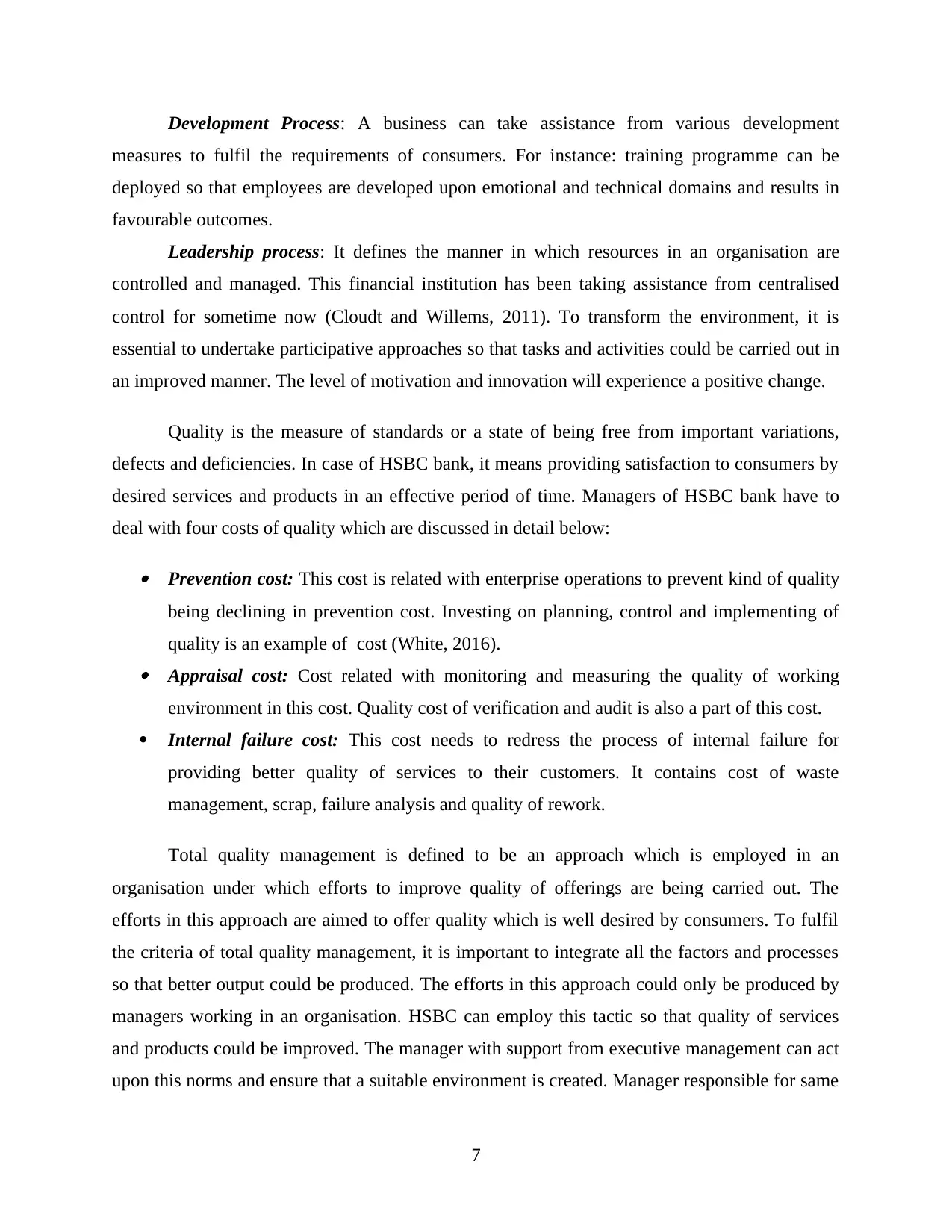
Development Process: A business can take assistance from various development
measures to fulfil the requirements of consumers. For instance: training programme can be
deployed so that employees are developed upon emotional and technical domains and results in
favourable outcomes.
Leadership process: It defines the manner in which resources in an organisation are
controlled and managed. This financial institution has been taking assistance from centralised
control for sometime now (Cloudt and Willems, 2011). To transform the environment, it is
essential to undertake participative approaches so that tasks and activities could be carried out in
an improved manner. The level of motivation and innovation will experience a positive change.
Quality is the measure of standards or a state of being free from important variations,
defects and deficiencies. In case of HSBC bank, it means providing satisfaction to consumers by
desired services and products in an effective period of time. Managers of HSBC bank have to
deal with four costs of quality which are discussed in detail below:
Prevention cost: This cost is related with enterprise operations to prevent kind of quality
being declining in prevention cost. Investing on planning, control and implementing of
quality is an example of cost (White, 2016). Appraisal cost: Cost related with monitoring and measuring the quality of working
environment in this cost. Quality cost of verification and audit is also a part of this cost.
Internal failure cost: This cost needs to redress the process of internal failure for
providing better quality of services to their customers. It contains cost of waste
management, scrap, failure analysis and quality of rework.
Total quality management is defined to be an approach which is employed in an
organisation under which efforts to improve quality of offerings are being carried out. The
efforts in this approach are aimed to offer quality which is well desired by consumers. To fulfil
the criteria of total quality management, it is important to integrate all the factors and processes
so that better output could be produced. The efforts in this approach could only be produced by
managers working in an organisation. HSBC can employ this tactic so that quality of services
and products could be improved. The manager with support from executive management can act
upon this norms and ensure that a suitable environment is created. Manager responsible for same
7
measures to fulfil the requirements of consumers. For instance: training programme can be
deployed so that employees are developed upon emotional and technical domains and results in
favourable outcomes.
Leadership process: It defines the manner in which resources in an organisation are
controlled and managed. This financial institution has been taking assistance from centralised
control for sometime now (Cloudt and Willems, 2011). To transform the environment, it is
essential to undertake participative approaches so that tasks and activities could be carried out in
an improved manner. The level of motivation and innovation will experience a positive change.
Quality is the measure of standards or a state of being free from important variations,
defects and deficiencies. In case of HSBC bank, it means providing satisfaction to consumers by
desired services and products in an effective period of time. Managers of HSBC bank have to
deal with four costs of quality which are discussed in detail below:
Prevention cost: This cost is related with enterprise operations to prevent kind of quality
being declining in prevention cost. Investing on planning, control and implementing of
quality is an example of cost (White, 2016). Appraisal cost: Cost related with monitoring and measuring the quality of working
environment in this cost. Quality cost of verification and audit is also a part of this cost.
Internal failure cost: This cost needs to redress the process of internal failure for
providing better quality of services to their customers. It contains cost of waste
management, scrap, failure analysis and quality of rework.
Total quality management is defined to be an approach which is employed in an
organisation under which efforts to improve quality of offerings are being carried out. The
efforts in this approach are aimed to offer quality which is well desired by consumers. To fulfil
the criteria of total quality management, it is important to integrate all the factors and processes
so that better output could be produced. The efforts in this approach could only be produced by
managers working in an organisation. HSBC can employ this tactic so that quality of services
and products could be improved. The manager with support from executive management can act
upon this norms and ensure that a suitable environment is created. Manager responsible for same
7
⊘ This is a preview!⊘
Do you want full access?
Subscribe today to unlock all pages.

Trusted by 1+ million students worldwide
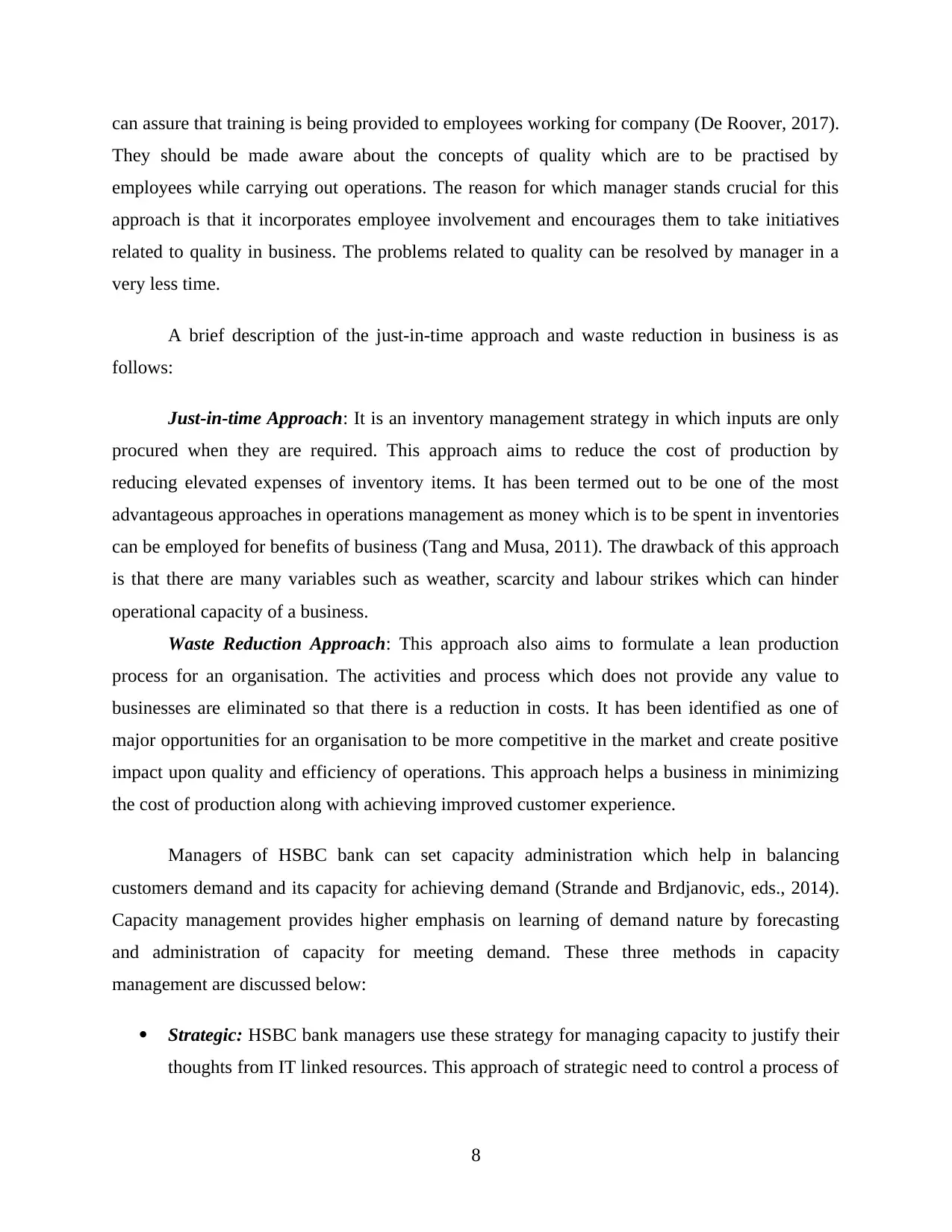
can assure that training is being provided to employees working for company (De Roover, 2017).
They should be made aware about the concepts of quality which are to be practised by
employees while carrying out operations. The reason for which manager stands crucial for this
approach is that it incorporates employee involvement and encourages them to take initiatives
related to quality in business. The problems related to quality can be resolved by manager in a
very less time.
A brief description of the just-in-time approach and waste reduction in business is as
follows:
Just-in-time Approach: It is an inventory management strategy in which inputs are only
procured when they are required. This approach aims to reduce the cost of production by
reducing elevated expenses of inventory items. It has been termed out to be one of the most
advantageous approaches in operations management as money which is to be spent in inventories
can be employed for benefits of business (Tang and Musa, 2011). The drawback of this approach
is that there are many variables such as weather, scarcity and labour strikes which can hinder
operational capacity of a business.
Waste Reduction Approach: This approach also aims to formulate a lean production
process for an organisation. The activities and process which does not provide any value to
businesses are eliminated so that there is a reduction in costs. It has been identified as one of
major opportunities for an organisation to be more competitive in the market and create positive
impact upon quality and efficiency of operations. This approach helps a business in minimizing
the cost of production along with achieving improved customer experience.
Managers of HSBC bank can set capacity administration which help in balancing
customers demand and its capacity for achieving demand (Strande and Brdjanovic, eds., 2014).
Capacity management provides higher emphasis on learning of demand nature by forecasting
and administration of capacity for meeting demand. These three methods in capacity
management are discussed below:
Strategic: HSBC bank managers use these strategy for managing capacity to justify their
thoughts from IT linked resources. This approach of strategic need to control a process of
8
They should be made aware about the concepts of quality which are to be practised by
employees while carrying out operations. The reason for which manager stands crucial for this
approach is that it incorporates employee involvement and encourages them to take initiatives
related to quality in business. The problems related to quality can be resolved by manager in a
very less time.
A brief description of the just-in-time approach and waste reduction in business is as
follows:
Just-in-time Approach: It is an inventory management strategy in which inputs are only
procured when they are required. This approach aims to reduce the cost of production by
reducing elevated expenses of inventory items. It has been termed out to be one of the most
advantageous approaches in operations management as money which is to be spent in inventories
can be employed for benefits of business (Tang and Musa, 2011). The drawback of this approach
is that there are many variables such as weather, scarcity and labour strikes which can hinder
operational capacity of a business.
Waste Reduction Approach: This approach also aims to formulate a lean production
process for an organisation. The activities and process which does not provide any value to
businesses are eliminated so that there is a reduction in costs. It has been identified as one of
major opportunities for an organisation to be more competitive in the market and create positive
impact upon quality and efficiency of operations. This approach helps a business in minimizing
the cost of production along with achieving improved customer experience.
Managers of HSBC bank can set capacity administration which help in balancing
customers demand and its capacity for achieving demand (Strande and Brdjanovic, eds., 2014).
Capacity management provides higher emphasis on learning of demand nature by forecasting
and administration of capacity for meeting demand. These three methods in capacity
management are discussed below:
Strategic: HSBC bank managers use these strategy for managing capacity to justify their
thoughts from IT linked resources. This approach of strategic need to control a process of
8
Paraphrase This Document
Need a fresh take? Get an instant paraphrase of this document with our AI Paraphraser
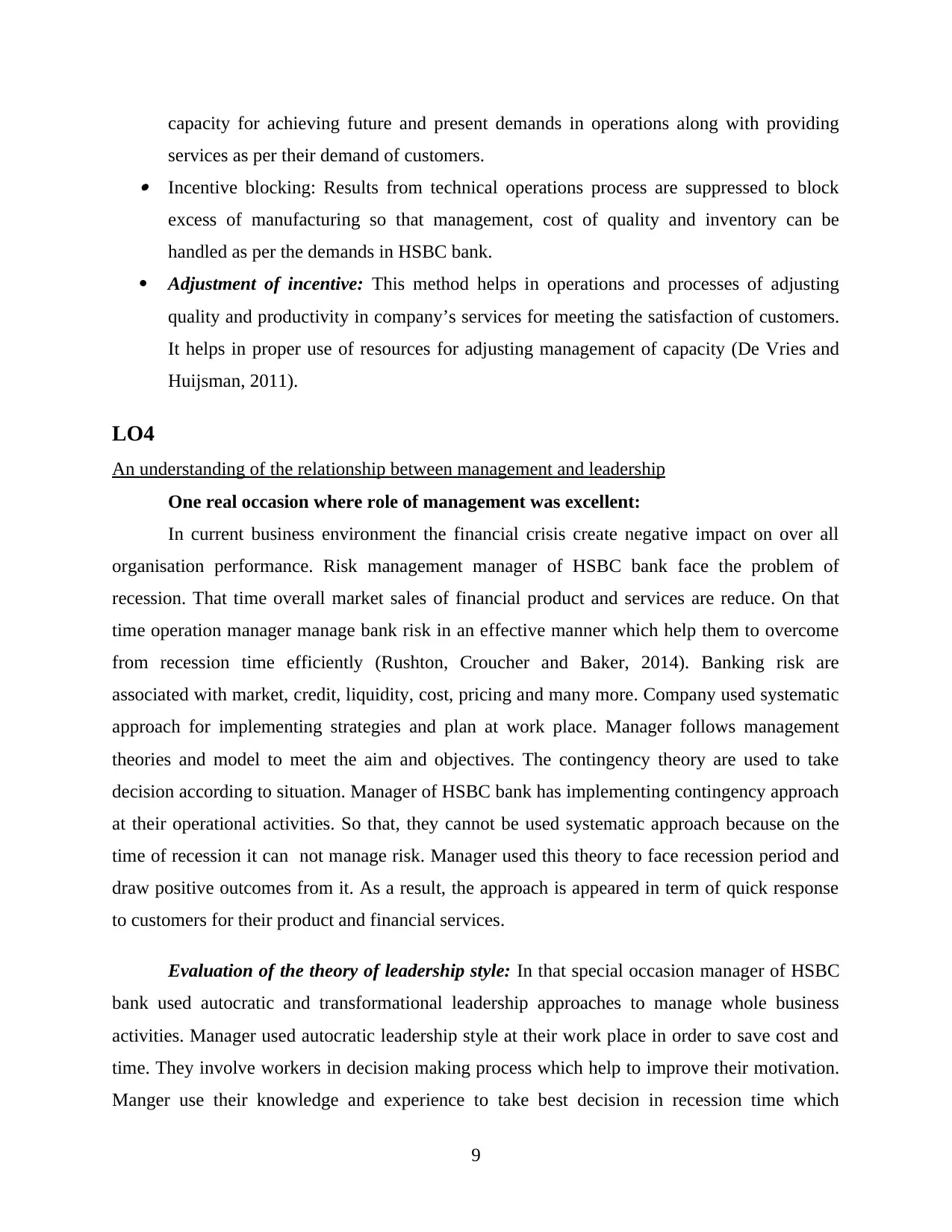
capacity for achieving future and present demands in operations along with providing
services as per their demand of customers. Incentive blocking: Results from technical operations process are suppressed to block
excess of manufacturing so that management, cost of quality and inventory can be
handled as per the demands in HSBC bank.
Adjustment of incentive: This method helps in operations and processes of adjusting
quality and productivity in company’s services for meeting the satisfaction of customers.
It helps in proper use of resources for adjusting management of capacity (De Vries and
Huijsman, 2011).
LO4
An understanding of the relationship between management and leadership
One real occasion where role of management was excellent:
In current business environment the financial crisis create negative impact on over all
organisation performance. Risk management manager of HSBC bank face the problem of
recession. That time overall market sales of financial product and services are reduce. On that
time operation manager manage bank risk in an effective manner which help them to overcome
from recession time efficiently (Rushton, Croucher and Baker, 2014). Banking risk are
associated with market, credit, liquidity, cost, pricing and many more. Company used systematic
approach for implementing strategies and plan at work place. Manager follows management
theories and model to meet the aim and objectives. The contingency theory are used to take
decision according to situation. Manager of HSBC bank has implementing contingency approach
at their operational activities. So that, they cannot be used systematic approach because on the
time of recession it can not manage risk. Manager used this theory to face recession period and
draw positive outcomes from it. As a result, the approach is appeared in term of quick response
to customers for their product and financial services.
Evaluation of the theory of leadership style: In that special occasion manager of HSBC
bank used autocratic and transformational leadership approaches to manage whole business
activities. Manager used autocratic leadership style at their work place in order to save cost and
time. They involve workers in decision making process which help to improve their motivation.
Manger use their knowledge and experience to take best decision in recession time which
9
services as per their demand of customers. Incentive blocking: Results from technical operations process are suppressed to block
excess of manufacturing so that management, cost of quality and inventory can be
handled as per the demands in HSBC bank.
Adjustment of incentive: This method helps in operations and processes of adjusting
quality and productivity in company’s services for meeting the satisfaction of customers.
It helps in proper use of resources for adjusting management of capacity (De Vries and
Huijsman, 2011).
LO4
An understanding of the relationship between management and leadership
One real occasion where role of management was excellent:
In current business environment the financial crisis create negative impact on over all
organisation performance. Risk management manager of HSBC bank face the problem of
recession. That time overall market sales of financial product and services are reduce. On that
time operation manager manage bank risk in an effective manner which help them to overcome
from recession time efficiently (Rushton, Croucher and Baker, 2014). Banking risk are
associated with market, credit, liquidity, cost, pricing and many more. Company used systematic
approach for implementing strategies and plan at work place. Manager follows management
theories and model to meet the aim and objectives. The contingency theory are used to take
decision according to situation. Manager of HSBC bank has implementing contingency approach
at their operational activities. So that, they cannot be used systematic approach because on the
time of recession it can not manage risk. Manager used this theory to face recession period and
draw positive outcomes from it. As a result, the approach is appeared in term of quick response
to customers for their product and financial services.
Evaluation of the theory of leadership style: In that special occasion manager of HSBC
bank used autocratic and transformational leadership approaches to manage whole business
activities. Manager used autocratic leadership style at their work place in order to save cost and
time. They involve workers in decision making process which help to improve their motivation.
Manger use their knowledge and experience to take best decision in recession time which
9
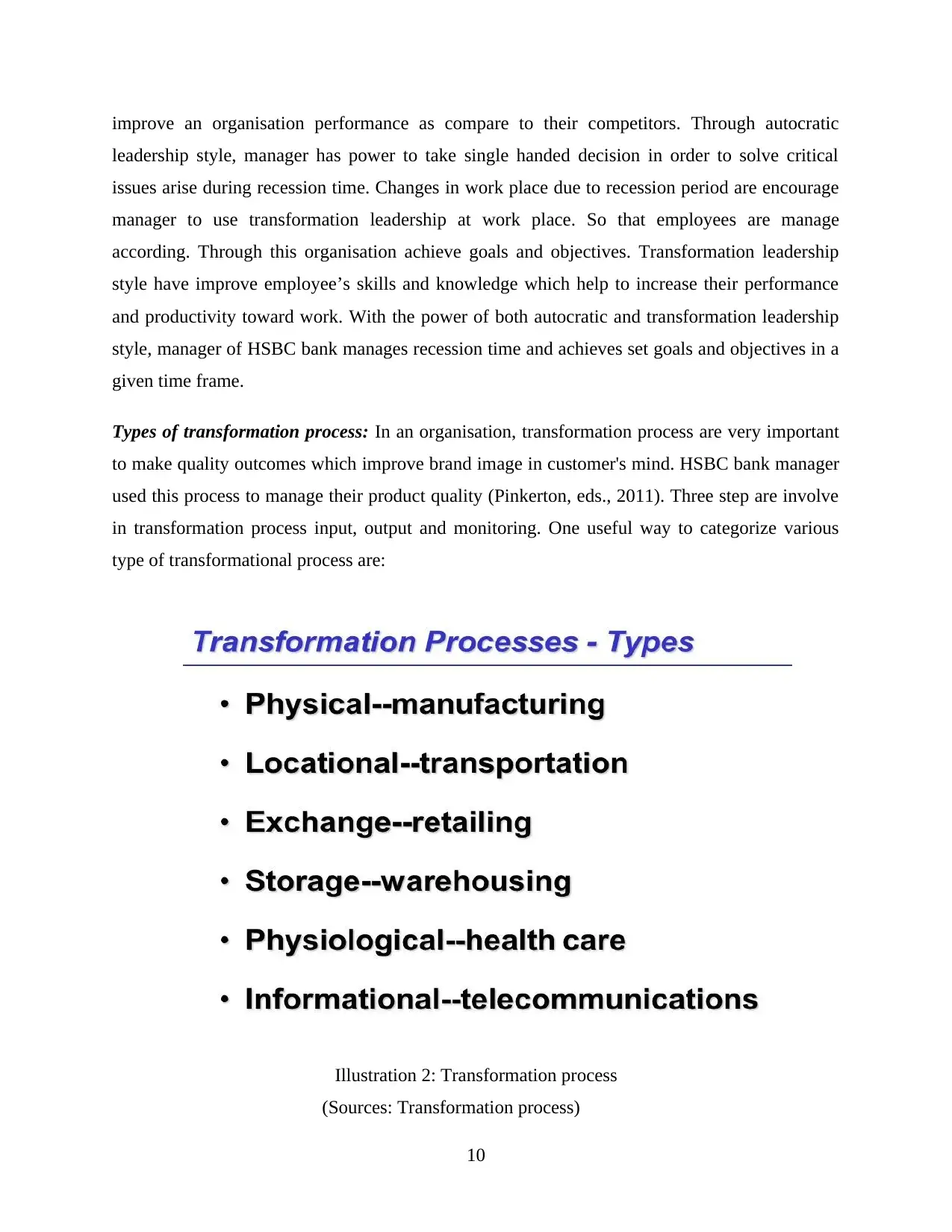
improve an organisation performance as compare to their competitors. Through autocratic
leadership style, manager has power to take single handed decision in order to solve critical
issues arise during recession time. Changes in work place due to recession period are encourage
manager to use transformation leadership at work place. So that employees are manage
according. Through this organisation achieve goals and objectives. Transformation leadership
style have improve employee’s skills and knowledge which help to increase their performance
and productivity toward work. With the power of both autocratic and transformation leadership
style, manager of HSBC bank manages recession time and achieves set goals and objectives in a
given time frame.
Types of transformation process: In an organisation, transformation process are very important
to make quality outcomes which improve brand image in customer's mind. HSBC bank manager
used this process to manage their product quality (Pinkerton, eds., 2011). Three step are involve
in transformation process input, output and monitoring. One useful way to categorize various
type of transformational process are:
(Sources: Transformation process)
10
Illustration 2: Transformation process
leadership style, manager has power to take single handed decision in order to solve critical
issues arise during recession time. Changes in work place due to recession period are encourage
manager to use transformation leadership at work place. So that employees are manage
according. Through this organisation achieve goals and objectives. Transformation leadership
style have improve employee’s skills and knowledge which help to increase their performance
and productivity toward work. With the power of both autocratic and transformation leadership
style, manager of HSBC bank manages recession time and achieves set goals and objectives in a
given time frame.
Types of transformation process: In an organisation, transformation process are very important
to make quality outcomes which improve brand image in customer's mind. HSBC bank manager
used this process to manage their product quality (Pinkerton, eds., 2011). Three step are involve
in transformation process input, output and monitoring. One useful way to categorize various
type of transformational process are:
(Sources: Transformation process)
10
Illustration 2: Transformation process
⊘ This is a preview!⊘
Do you want full access?
Subscribe today to unlock all pages.

Trusted by 1+ million students worldwide
1 out of 16
Related Documents
Your All-in-One AI-Powered Toolkit for Academic Success.
+13062052269
info@desklib.com
Available 24*7 on WhatsApp / Email
![[object Object]](/_next/static/media/star-bottom.7253800d.svg)
Unlock your academic potential
Copyright © 2020–2025 A2Z Services. All Rights Reserved. Developed and managed by ZUCOL.


